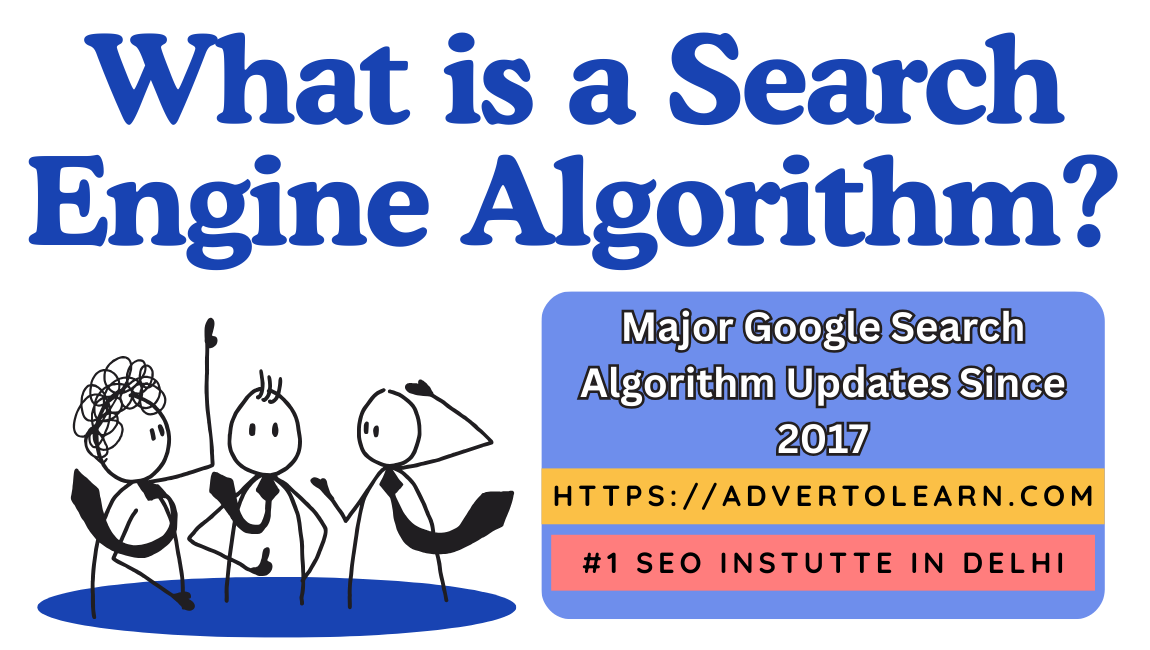
A Search Engine Algorithm is a mathematical calculation, or simply a formula, that determines and displays the most relevant information from indexed web pages stored in the search engine’s database. This is done by analysing the relevancy of the user’s search query.
Search algorithms play a very critical role in displaying the most accurate and informative results on search engines. Hence, it becomes important for Digital Marketing and SEO professionals to understand the functions and significance of each major Google search algorithm, so they can perform SEO more effectively.
Not just this, in SEO job interviews, candidates are often asked questions related to algorithms and the latest algorithm updates. This helps interviewers assess a candidate’s knowledge of current trends in search and evaluate whether they are a good fit for the role.
In this blog post on Search Engine Algorithms, I have covered all the major Google algorithm updates since 1997 that have contributed to Google becoming the most successful search engine of all time.
If we look back into the earlier years of SEO, there were four main well-known algorithms that were widely used in Google Search. However, as the use of the internet and smartphones started growing rapidly, Google faced new challenges in delivering customised, relevant, and faster search results for different types of queries. To address these, Google introduced three additional algorithms which are currently in use alongside the earlier four.
To make these updates easier to understand, I have divided them into two categories:
- Google’s Old Age Search Engine Algorithm Updates
- Google’s New Age Search Engine Algorithm Updates
I have explained both in detail below.
Google Algorithm Updates by Year (1996–2020)
1997
- Google domain registered on 15 September 1997.
1998
- PageRank Algorithm introduced – Google officially launched; ranking based on backlinks.
1999
- No major named update – Google was still growing.
2000
- Google Toolbar launched → introduced PageRank score visibility.
Foundation Era (1996–2000)
- 1996–1997: Google started as BackRub at Stanford, later registered as Google.com.
- 1998: Launch of PageRank algorithm – Google ranked websites based on backlinks.
- 2000: Google Toolbar introduced visible PageRank scores, starting the SEO industry’s obsession with link authority.
2001
- Early tweaks to PageRank, link-based evaluations.
2002
- First documented algorithm changes (not named). Early SEO noticed big shifts.
2003
- Boston Update (Feb 2003) – first named update.
- Florida Update (Nov 2003) – cracked down on keyword stuffing & spammy tactics.
2004
- Brandy Update – introduced Latent Semantic Indexing (LSI) → Google understood context better.
2005
- Nofollow Tag Introduced → to fight comment spam.
- Big Daddy (infrastructure update).
2006
- No huge named updates; focus on infrastructure.
2007
- Universal Search → integrated images, news, video into SERPs.
2008
- Dewey Update – affected rankings, caused debate.
2009
- Vince Update → Favoured big brands in rankings.
- Caffeine Preview announced – infrastructure improvement for faster indexing.
2010
- MayDay Update → targeted long-tail low-quality content.
- Caffeine Rollout (June 2010) → faster indexing, real-time search.
- Google Places integrated into local search.
Early Growth & Spam Fighting Era (2001–2010)
- 2003: First named updates – Boston and Florida. Florida was especially harsh on keyword stuffing, signalling the end of spammy SEO.
- 2004–2005: Brandy Update introduced semantic analysis (understanding context, not just keywords). Google also launched nofollow tag to fight blog spam, and Big Daddy update improved infrastructure.
- 2007: Universal Search integrated news, images, and videos into results.
- 2009–2010: Vince Update favoured big brands; Caffeine improved speed and indexing; MayDay targeted thin long-tail content.
2011
- Panda Update (Feb 2011) → cracked down on “content farms” & thin content.
2012
- Venice Update → improved local search integration.
- Penguin Update (Apr 2012) → targeted manipulative link building.
- Exact Match Domain (EMD) Update → penalised low-quality exact-match domains.
2013
- Hummingbird Update → major revamp to understand conversational queries.
2014
- Pigeon Update → improved local search signals.
- SSL/HTTPS Update → secure sites given slight ranking boost.
2015
- Mobilegeddon (Apr 2015) → mobile-friendliness became ranking factor.
- RankBrain (Oct 2015) → machine learning for better query interpretation.
Quality Control Era (2011–2015)
- 2011: Panda Update cracked down on “content farms” and thin content.
- 2012: Penguin Update targeted manipulative backlinks; Venice improved local results; Exact Match Domain Update penalised poor-quality keyword domains.
- 2013: Hummingbird completely revamped search → focus shifted to conversational queries and semantic meaning.
- 2014: Pigeon Update tightened integration of local SEO with organic SEO; HTTPS became a minor ranking factor.
- 2015: Mobilegeddon made mobile-friendliness essential; RankBrain introduced machine learning to interpret search intent.
2016
- Possum Update → refined local search results, filtered duplicates.
- Penguin became part of Google’s core algorithm (real-time).
2017
- Fred Update (Mar 2017) → penalised ad-heavy, low-value sites.
- Hawk Update (Aug 2017) → fixed over-filtering in local search.
2018
- Medic Update (Aug 2018) → impacted health/YMYL sites, focus on E-A-T.
- Mobile-First Indexing began rolling out.
2019
- March 2019 Core Update (first officially named “Core Update”).
- BERT Update (Oct 2019) → natural language processing to better understand context.
2020
Stronger emphasis on E-A-T (Expertise, Authoritativeness, Trustworthiness).
Core Updates in Jan, May, Dec 2020 → refined content quality signals.
AI, Local SEO & Mobile Era (2016–2020)
- 2016: Possum Update refined local SEO, filtering duplicate business listings. Penguin was integrated into the core algorithm, working in real-time.
- 2017: Fred Update penalised ad-heavy, low-value websites; Hawk Update corrected over-filtering from Possum, helping legitimate nearby businesses.
- 2018: Medic Update (Aug) shook up YMYL (Your Money Your Life) industries like health and finance, pushing E-A-T (Expertise, Authoritativeness, Trustworthiness). Mobile-first indexing began rolling out fully.
- 2019: BERT Update (Oct) → a breakthrough in AI-based search, helping Google understand natural language and context.
- 2020: Multiple Core Updates (Jan, May, Dec) refined quality, relevance, and authority. Focus shifted heavily to E-A-T and content trustworthiness.
Google’s New Age (2021 to 2025) Search Engine Algorithm Updates
2021
- Vicinity Update (Nov 30 – Dec 8, 2021)
The largest local search update since 2017, Vicinity prioritised businesses physically close to the searcher—boosting small local businesses and reshaping local SERP dynamics
2021 – Local Search Transformation
- The Vicinity Update (Nov–Dec 2021) was the biggest local SEO change since 2017.
- It placed heavy emphasis on proximity – businesses closer to the searcher got preference.
- This helped smaller local businesses compete with bigger brands, reshaping Google’s Local Pack rankings.
2022
- May 2022 Core Update (May 25 – June 9)
Significantly affected news and media publishers; generalist news sites, reference sites (like dictionaries, lyric sites) saw drops, while video-heavy platforms like YouTube, TikTok, Hulu, Disney+, and Twitch gained rankings. - August 2022 Helpful Content Update (Aug–Sep rollout)
Targeted content created solely for search ranking over user value and demoted such low-value pages. - September 2022 Core Update (Sep 12, ~14 days rollout)
A routine update focused on improving relevance and overall core ranking factors; caused moderate ranking volatility. - December 2022 Helpful Content Update
Expanded the helpful content classifier globally to better reduce unhelpful, SEO-first content.
2022 – Helpful Content Era Begins
- Core Updates (May & Sep 2022): Adjusted rankings to prioritise more relevant, authoritative content. News sites and reference websites were impacted; video platforms gained visibility.
- Helpful Content Update (Aug 2022): A new system to demote “SEO-first” content that was written only to rank, not to help users.
- Helpful Content Expansion (Dec 2022): Rolled out globally to filter out shallow or AI-spun articles.
Impact: 2022 was the turning point where Google clearly shifted towards rewarding authentic, user-focused content over manipulative SEO tactics.
2023
- March 2023 Core Update (Mar 15–28)
A broad core update with marked volatility, especially impacting shopping and entertainment sectors. - April 2023 Reviews Update (Apr 12–25)
Focused on elevating high-quality, in-depth review content across websites offering product advice, opinions, or analysis. - August 2023 Core Update (Aug 22 – Sep 7)
Beneficiaries included user-generated content like Reddit and experienced websites in niche topics. - September 2023 Helpful Content Update (Sep 14–27)
Global enhancement of Google’s helpful content system; third iteration, further deprioritised AI-generated or surface-level content. - October 2023 Spam Update (Oct 4–19)
Expanded language support and spam detection capabilities across global searches. - October 2023 Core Update (Oct 5–19)
Another broad core refresh noted for ranking volatility, also addressed a Discover traffic bug. - November 2023 Core Update (Nov 2–28)
Unusual back-to-back monthly core updates with notable ranking shifts. - November 2023 Reviews Update (Nov 8 – Dec 7)
Continued focus on review content quality and authenticity.
2023 – Core Volatility & Reviews Focus
- Core Updates (Mar, Aug, Oct, Nov): Several major updates throughout the year brought high volatility. Many industries, from shopping to entertainment, saw repeated fluctuations.
- Reviews Updates (Apr & Nov): Focused on authentic, in-depth reviews over generic product roundups. Rewarded sites with expertise.
- Helpful Content Update (Sep 2023): Third iteration, stronger against low-value or AI-only content.
- Spam Update (Oct 2023): Expanded spam detection in multiple languages.
Impact: 2023 became known for frequent, back-to-back updates. Websites relying on thin content or fake reviews were heavily penalised, while UGC (Reddit, niche forums) gained traction.
2024
- March 2024 Core Update (with Spam Update) (Mar 5 – Apr 19)
Tackled low-quality content, combating content scale abuse, reputation abuse, and expired domains. - March 2024 Spam Update (Mar 5 – Mar 20)
Launched alongside core update to enhance spam filtering systems. - June 2024 Spam Update (Jun 20 – Jun 27)
Continued improvements to automated spam detection. - Explicit Fake Content Update
Targeted AI-generated deepfakes and non-consensual explicit content. - August 2024 Core Update (Aug 15 – Sep 3)
Aimed to promote authentic high-quality content over SEO-centric pages. - November 2024 Core Update (Nov 11 – Dec 5)
Continued refining search quality and relevance. - December 2024 Core Update (Dec 12 – Dec 18)
Came shortly after November’s core update, reflecting rapid refinement.
2024 – Crackdown on Spam & AI Misuse
- March 2024 Core Update (with Spam Update): Targeted content scale abuse (mass AI-generated spam), reputation abuse (misuse of trusted domains), and expired domain abuse.
- June 2024 Spam Update: Further fine-tuned spam detection.
- Explicit Fake Content Update (Jun 2024): Specifically targeted AI-generated deepfakes and explicit content, reflecting societal concerns.
- Core Updates (Aug, Nov, Dec): Continued refining content quality signals.
Impact: 2024 clearly became the year where Google moved aggressively against AI abuse and spam, ensuring that AI-generated content had to be useful, trustworthy, and human-aligned.
2025
- March 2025 Core Update (Mar 13 – Mar 27)
First core refresh of 2025, continued emphasis on ranking relevance and user experience. - June 2025 Core Update (Jun 30 – Jul 17)
Second core update of the year, rolled out globally, further highlighting content satisfaction as a ranking driver. - AI Overviews & AI Mode
AI Overviews (summarised answers via Gemini model) expanded globally by late 2024; lawsuit filed by Chegg in Feb 2025 challenging its impact.
In March 2025, Google began testing AI Mode—a fully AI-generated search experience using query breakdown and multimodal outputs.
2025 – The AI Search Revolution
- March 2025 Core Update: Continued relevance and quality adjustments.
- June 2025 Core Update: Reinforced the focus on user satisfaction signals.
- AI Overviews Expansion: Originally launched in 2024, AI summaries were now globally integrated, changing how users interact with results.
- AI Mode in Search (Mar 2025): A dramatic shift – powered by Google Gemini, AI Mode allows complex queries, multimodal responses (text, images, voice), and directly answers questions instead of just linking to websites.
Impact: 2025 marked the biggest change to Google Search in decades – moving from a “list of links” search engine to a conversational, AI-driven assistant.


0 Comments